-
You can buy this type of basil fresh as a whole plant
(from the produce section of your grocery store)
from late Spring - early Fall, but I grow my herbs myself...
-
You can shop at Home Depot or Lowe's, but I buy all my supplies from Target:
-
I use Miracle-Gro® Potting Mix,
and I buy Genovese basil seed packets, along with some pots:
Small enough to fit on a window sill but large enough to hold a full-size basil plant.
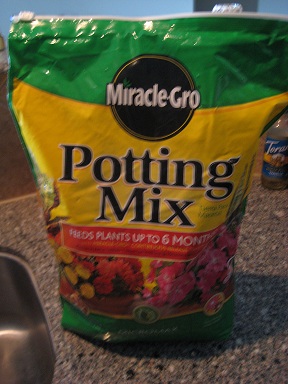
-
Basil is an herb from the mint family:
It is known for its sweet flavor and oily texture
(just gently rubbing its leaves is enough to smell its strong aroma).
-
Sweet basil is better for tomato-based sauces
(e.g., spaghetti, Margherita pizza, etc.)
as it adds a sweet flavor to the sauce and provides color.
Lemon and cinnamon basil are other varieties that still look like basil,
but actually smell and taste like lemon & cinnamon!
Lemon basil is a much lighter green than Genovese,
and cinnamon basil will eventually grow small purple flowers...
I sometimes put lemon & cinnamon basil in salads for their vibrant flavor.
-
Genovese basil is specifically known for use in pesto:
A viscous, green sauce meant for flat-breads (e.g., pizza) and of course, pasta.
Due to the strong fragrance and pungent flavor,
the only protein I recommend using (if any at all) is small chunks of chicken,
although the protein from the nuts is enough in my opinion.
-
Also, due to the amount of oil, nuts, and cheese
makes this meal a heavy meal due to the high fat content
(plus the carbs from the pasta)...notice I put FRESH in the ingredients list:
Pesto is a 'seasonal specialty' for me as it is best served using only the freshest of ingredients,
not leftover nuts from the pantry or old cheese from the fridge etc.
One bowl of this on a warm afternoon or early evening
(when you have not had much if anything else to eat) is very satisfying!
-
I recommend using capellini as it is a thinner,
perhaps even softer pasta than say spaghetti or fettucini etc.
The noodles are better for mixing the sauce than say trying to get smaller,
tube-shaped pasta (e.g., penne) to absorb the sauce...
I suggest serving it in a bowl as the oil can run all over a plate,
and a bowl makes a smaller portion (which is still heavy in calories)
look more and to serve it with the sauce already mixed...
-
As far as growing the basil, you should plant indoors (on your window sill)
so as not to expose to the outside elements, especially pests such as bugs
(although fruit flies are almost impossible to avoid--I do not know how they get in!).
I also grow indoors because then I know the herbs are clean,
and therefore do not need rinsing after harvesting which cannot be stored at that point
(they will rot) and washes off all the nutrients & flavor found in the oils...
For this recipe I also should mention avoid chopping the herbs in any way for similar reasons...
-
After filling each pot approx. 95% w/the potting soil,
(I fill 3 pots--spread across a window sill near my kitchen that gets plenty of light)
Use 1 packet of seeds and spread them across
by pouring from the package into your hand & then into the soil,
then LIGHTLY press them into the soil and soak (I only ever use filtered water)
the entire surface of the soil each day so that it neither looks or feels dry...
Seeds will start budding in 1 week...
I recommend starting no early than late March to avoid cold temperatures
(which breads fungus, small mushrooms even, and eventually kills the plant)
and harvesting 2 months later--never later than October!
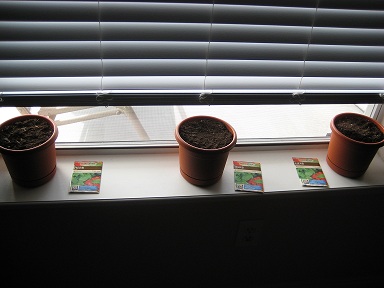
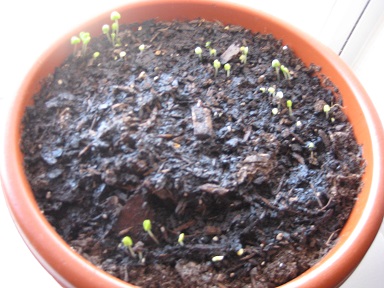 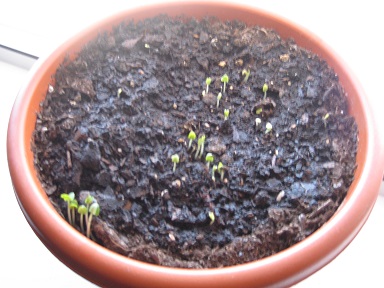
Basil plants: Day 10 (already starting to bud!)
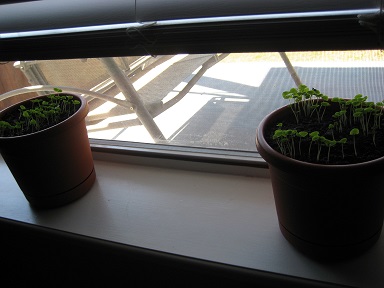 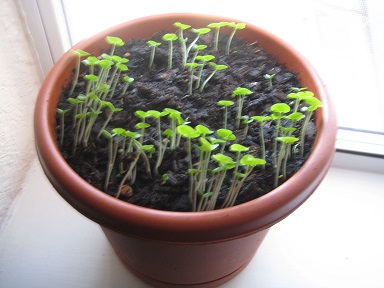
Genovese Basil: After 2 weeks...
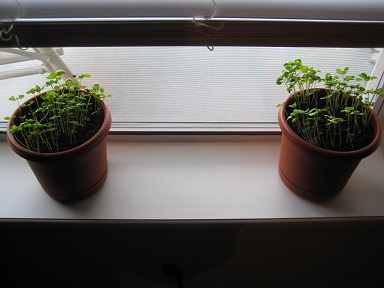 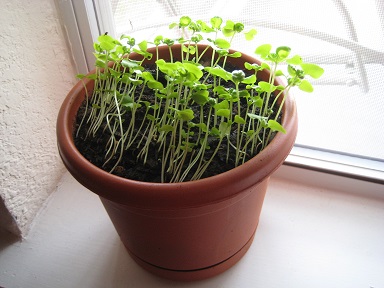
Genovese Basil: Approx. 1 month...
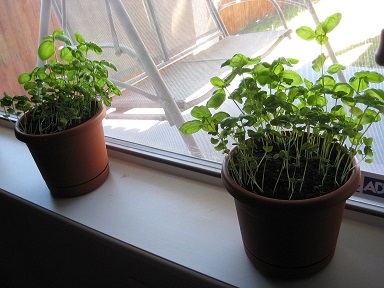 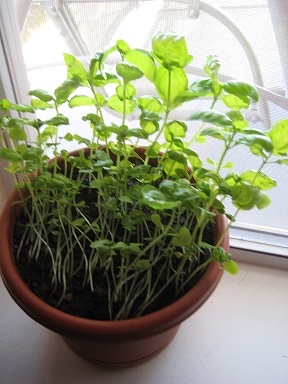
Genovese Basil: Approx. 2 months...
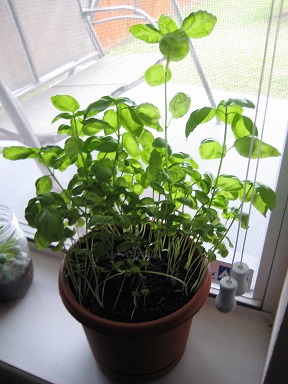 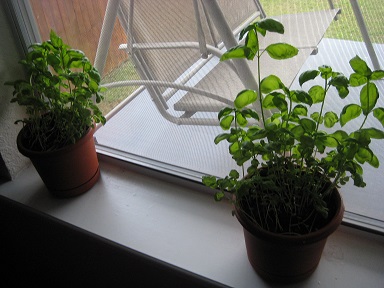
Genovese Basil: Approx. 3 months...
-
I also recommend watering slowly (with a small cup) and on the soil--not the plant,
either in the morning or evening when there is still sun...
Basil does not seem to like being drenched or 'fed' late at night (it's NOT a Gremlin!),
as it loves full sun to help absorb the water.
On rainy days the soil will probably be moist enough to skip watering,
as the plant did not get full-sun.
In addition, you will need to raise your blinds higher each week as the plant grows.
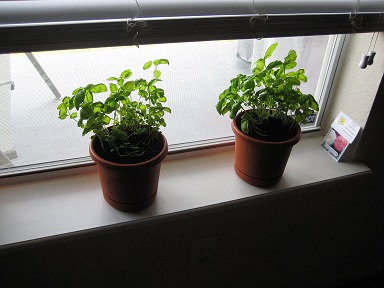
-
To harvest, put the pot (with plant in it) in your sink and bring your trash can nearby,
and get a paper towel on the counter...now, one-by-one, pinch off each leaf
(pinching, not plucking, avoids the stem which can be bitter and tough)
and place onto the paper towel.
Some smaller leaves will not be ready for harvest...believe it or not--after this process,
you CAN place this back on your window sill (if still in warmer months)
and the leaves will grow back!
Yes--basil is historically 'used' to be eaten by something.
so plucking it naturally cultivates its growth--almost like a haircut!
Otherwise, when you are done harvesting,
try to grab all stems as close to the soil as possible and lift--then throw them
(with extra soil and roots that come up) into your trash...
You can re-use the soil for something else if you want,
but you should wash your hands before continuing!
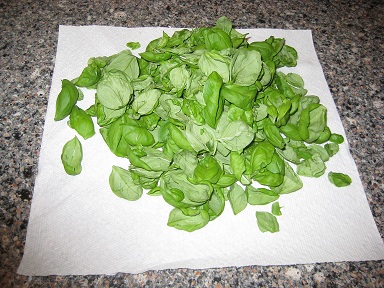
-
The basil can now be put into a measuring cup
(to ensure you have 2 full cups, if you press down you should still get at least 4 oz. without the extra air),
or you can transfer by pouring from the paper towel into a sandwich bag, and sealing out all the air...
Then, using a Sharpie, you should label what it is and the date before storing in a freezer...
Herbs are good up to a year--just thaw for at least an hour before using!
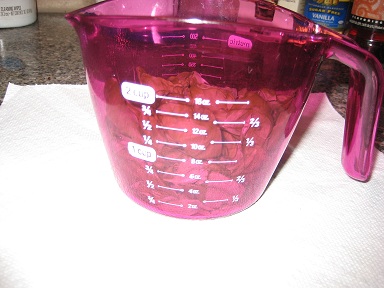
|
|